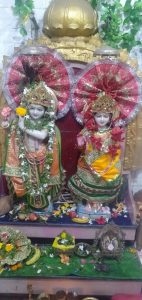Sambalpur: At the break of dawn, voices soaked in devotion rented the air on Sunday morning with people chanting Vishnu Sahasranama Parayana and Kartik Purana on the auspicious occasion of Anla Navami here.
In Odisha, Anla Navami is observed on Shukla Navami during Kartik Month as per Hindu calendar. As the name suggest, it is all about worshiping the Indian gooseberry tree.
People in Sambalpur and elsewhere in the state perform religious ceremonies like holy bath, puja and charity for atonement of sins and fulfilment of their wishes.
The tradition of worshipping the amla tree on Kartik Navami can be traced to ancient scriptures, which mentions it as a favourite fruit of Lord Vishnu and that all gods and goddesses reside in that tree. On the occasion, devotees consecrate and anoint Lord Vishnu with amla fruits. They also cook food under an amla tree and offer Naivedya (offerings) to the God.
According to priest Debendraa Nanda of Radha Krishna Temple here, amla trees are found on most temple premises. “We spend the day under the tree, light incense sticks and lamp and do Pradakshinam (going around the tree seven times),” he said.
RADHA PADA DARSHAN
 Nanda said that the other significance of the occasion is that it is the only day when devotees can have ‘Radha Pada Darshan’.
Nanda said that the other significance of the occasion is that it is the only day when devotees can have ‘Radha Pada Darshan’.
A ritual also followed at Sakshigopal Temple at Satyabadi in Puri district, where thousands of devotees from across the state flock to for a glance of holy feet of Goddess Radha on Amla Navami Tithi.
Legend has it that the temple was originally without a statue of Radha. Once, Lakhmi, daughter of a priest and believed to be an incarnation of Radha, pointed out as to how Lord Krishna (here as Gopala) can be worshipped without his true love Radha. It was then that a statue of the deity was brought from North India and installed here. The statue was originally adorned with ghagra and choli but when it was re-cladded in a traditional Odisha saree , the feet of the statue became visible and the priests took it as a holy sign. From that day, the deity is clad in a saree on Amla Navami and pilgrims are allowed inside the temple to touch the goddess’s feet.
IN THE LAP OF NATURE
At Rupapli village in Sambalpur, the occasion sees people gathering in large numbers early in the morning to conduct the rituals. “This festival celebrates all that nature has given us. Travelling to the village help us reconnect with our roots while enjoying the festivities in the lap of nature. Amla tree, its traditional richness and flavour of this festival bring us back to Rupapali every year,“ said Soudamini Mishra of Sambalpur town.
ANOTHER BELIEF
 Anla Navami also known as Akshaya Navami. It is believed that Satya Yuga began on the day of Akshaya Navami. Hence, Akshaya Navami day is also known as Satya Yugadi and it is very significant for all sorts of Daan-Punya activities. As the name Akshaya suggests, the reward of doing any charitable or devotional activities on this day would never diminish and benefit the person not only in this life but also in his next incarnations. The day of Akshaya Navami is as significant as the day of Akshaya Tritiya . While Akshaya Tritiya is Treta Yugadi, the day when Treta Yuga out of four Yugas began, Akshaya Navami is Satya Yugadi.
Anla Navami also known as Akshaya Navami. It is believed that Satya Yuga began on the day of Akshaya Navami. Hence, Akshaya Navami day is also known as Satya Yugadi and it is very significant for all sorts of Daan-Punya activities. As the name Akshaya suggests, the reward of doing any charitable or devotional activities on this day would never diminish and benefit the person not only in this life but also in his next incarnations. The day of Akshaya Navami is as significant as the day of Akshaya Tritiya . While Akshaya Tritiya is Treta Yugadi, the day when Treta Yuga out of four Yugas began, Akshaya Navami is Satya Yugadi.
In West Bengal, the very same day is observed as Jagaddhatri when the Goddess of Satta, Jagaddhatri is worshipped.
WHAT AYURVEDA SAYS
The Amalaki plant, as it is called in Sanskrit, is considered as one of the most potent and nourishing fruit. The Charaka Samhita says, “Amalaki is the best among rejuvenating herbs.” All parts of the plant, including the fruit, seed, leaves, root, bark and flowers, are used inAyurvedic herbal preparations. Amla berry is rich in Vitamin C, containing about 720 to 921 mg of Vitamin C for every hundred grams of edible material. It is the most concentrated form of Vitamin C found in the plant kingdom. “Amla pacifies vata, pitta, and kapha, though it is especially calming to pitta. In Sharad Ritu (autumn), pitta elements of our body increases and Amla helps in pacification. Amla is also a tonic for the heart, the arterial system, the respiratory system, the sense organs, and the mind,” informed Ayurvedic physician Sreekanth Ramanan.


